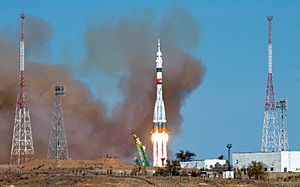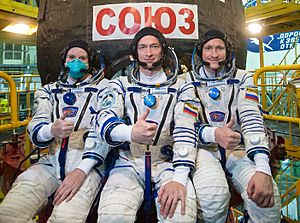Soyuz MS-17 facts for kids

Favor launches atop a Soyuz-2.1a
|
|
| Names | ISS 63S |
|---|---|
| Mission type | Crewed mission to ISS |
| Operator | Roscosmos |
| Website | https://www.roscosmos.ru/ |
| Mission duration | 184 days, 23 hours, 10 minutes |
| Spacecraft properties | |
| Spacecraft | Soyuz MS No.747 Favor |
| Manufacturer | RSC Energia |
| Crew | |
| Members |
|
| Start of mission | |
| Launch date | 14 October 2020, 05:45:04 UTC |
| Rocket | Soyuz-2.1a (s/n Х15000-045) |
| Launch site | Baikonur, Site 31 |
| Contractor | RSC Progress |
| End of mission | |
| Landing date | 17 April 2021, 04:55 UTC |
| Landing site | Kazakh Steppe, Kazakhstan |
| Orbital parameters | |
| Reference system | Geocentric orbit |
| Regime | Low Earth orbit |
| Inclination | 51.66° |
| Docking with ISS | |
| Docking port | Rassvet nadir |
| Docking date | 14 October 2020, 08:48:47 UTC |
| Undocking date | 19 March 2021, 16:38:27 UTC |
| Time docked | 156 days, 7 hours and 49 minutes |
| Docking with ISS (Relocation) |
|
| Docking port | Poisk zenith |
| Docking date | 19 March 2021, 17:12:35 UTC |
| Undocking date | 17 April 2021, 01:34 UTC |
| Time docked | 28 days, 8 hours and 21 minutes |
 Rubins, Ryzhikov, and Kud-Sverchkov Soyuz programme (crewed)
|
|
Soyuz MS-17 was a special space mission that launched on October 14, 2020. It carried three astronauts and cosmonauts to the International Space Station (ISS). This mission was the 145th time a Soyuz spacecraft carried people into space. The crew included a Russian commander, a Russian flight engineer, and an American flight engineer.
This mission was the first to use a super-fast way to reach the ISS. The Soyuz MS-17 arrived at the space station in about three hours after launching. This was much quicker than previous missions.
On March 19, 2021, the crew moved their Soyuz MS-17 spacecraft from one part of the ISS (called Rassvet) to another (called Poisk). They did this to make space for the next spacecraft, Soyuz MS-18, which launched on April 9, 2021. The Soyuz MS-18 brought new crew members to the ISS. The two spacecraft were docked at the ISS at the same time for nine days. This was important to make sure there were always Russian cosmonauts on the Russian part of the ISS.
Meet the Crew
This section introduces the brave people who flew on the Soyuz MS-17 mission.
Main Crew Members
| Position | Crew member | |
|---|---|---|
| Commander | Expedition 63/64 Second spaceflight |
|
| Flight Engineer 1 | Expedition 63/64 First spaceflight |
|
| Flight Engineer 2 | Expedition 63/64 Second spaceflight |
|
Backup Crew Members
These astronauts and cosmonauts were ready to fly if the main crew could not.
| Position | Crew member | |
|---|---|---|
| Commander | ||
| Flight Engineer 1 | ||
| Flight Engineer 2 | ||
Images for kids
See also
 In Spanish: Soyuz MS-17 para niños
In Spanish: Soyuz MS-17 para niños



